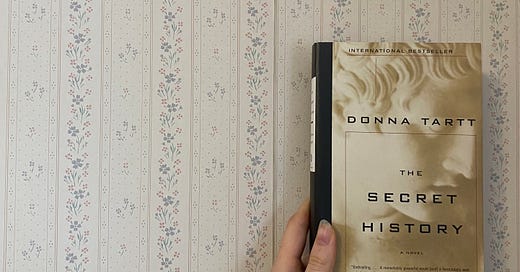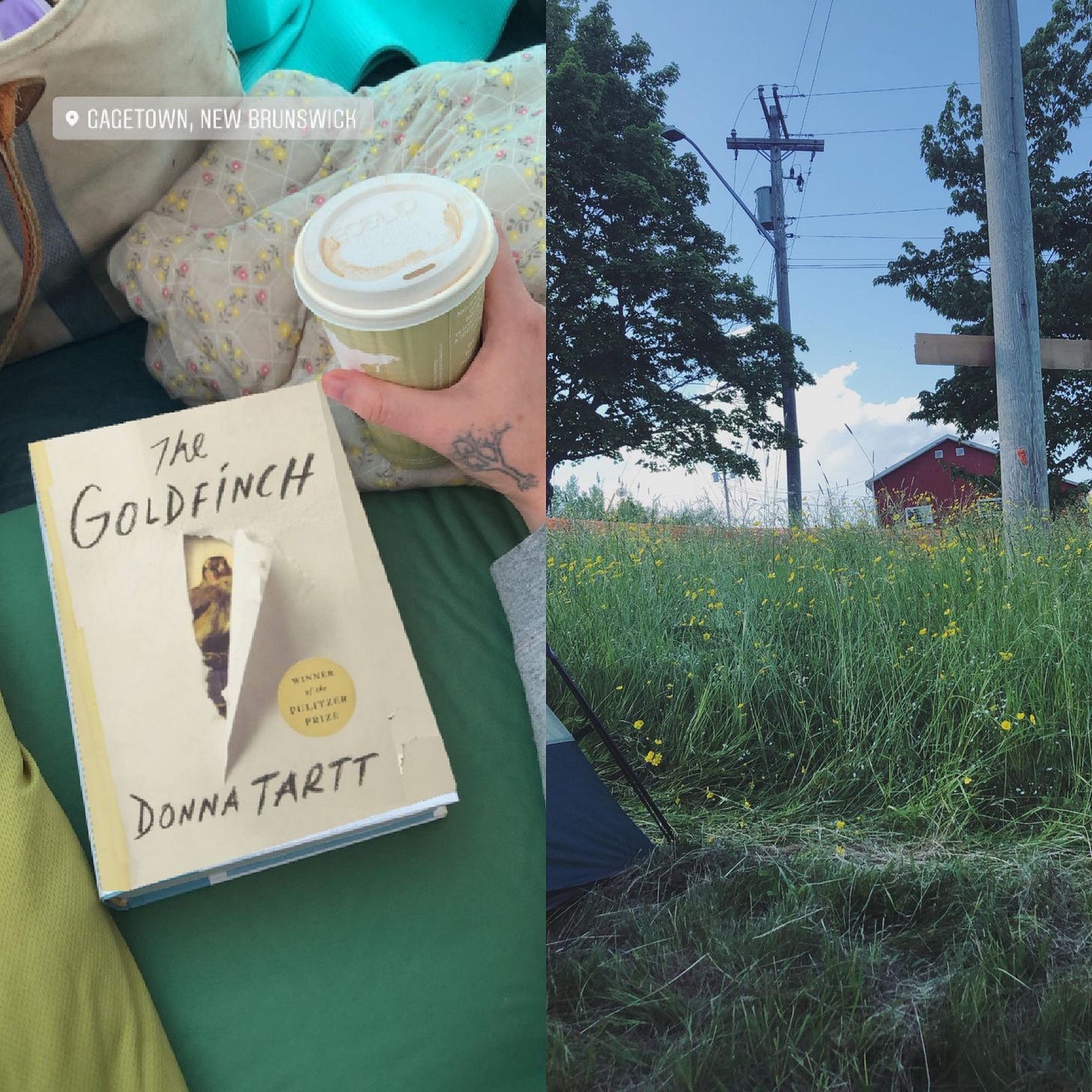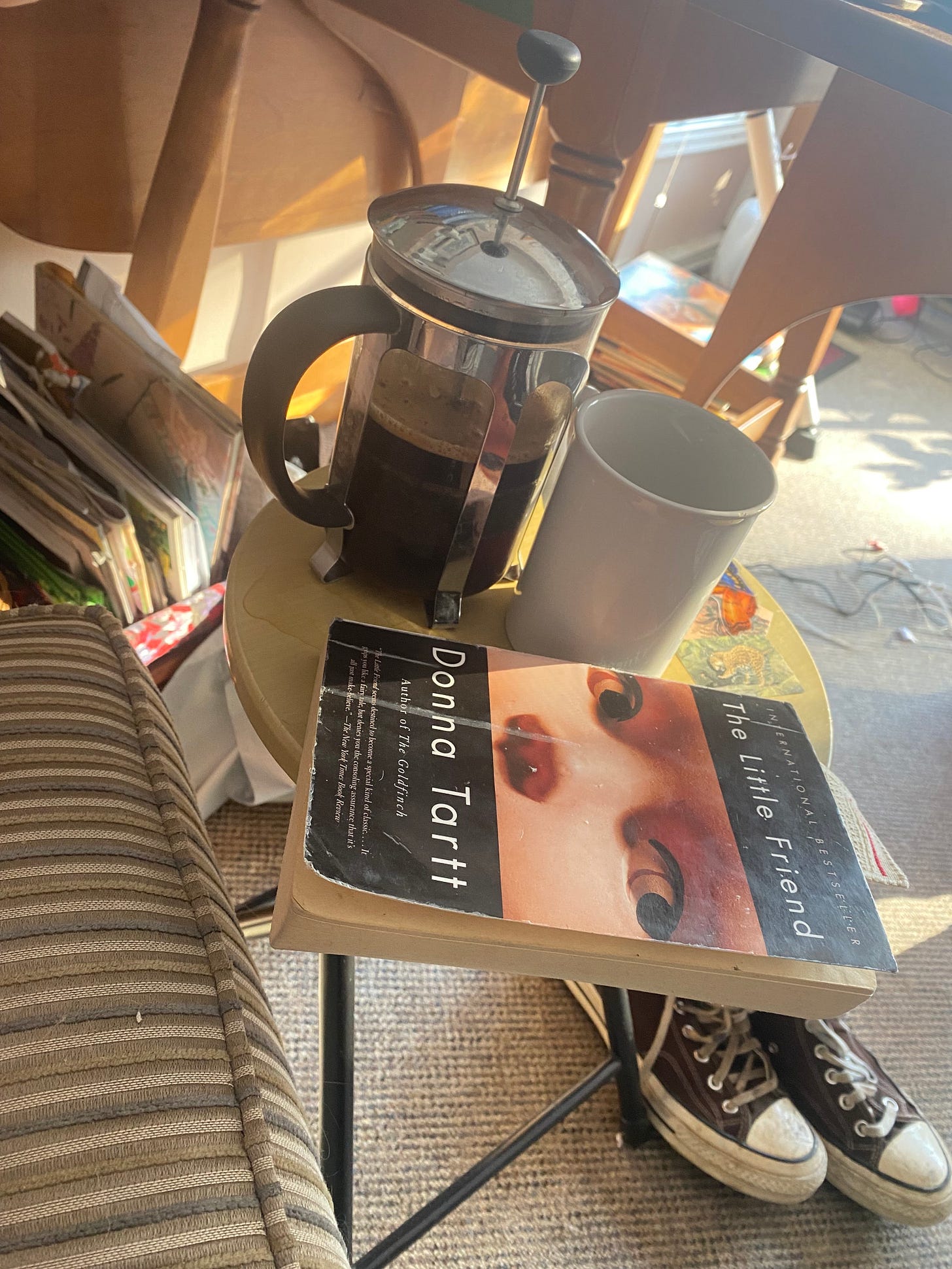donna tartt: a retrospective
Some thoughts on Tartt's three novels, and how I feel about them now.
The context in which I first read Donna Tartt couldn’t have been further from the novel’s setting. I was 23, an undergraduate student once again after dropping out of university at 20 and losing most of my credits, and working a summer job at a tiny hippie music festival known as FollyFest. My boss regularly biked around shirtless and shoeless, showing off his single nipple ring; supervisors wore tails as accessories and scheduled “safety meetings” that were code for weed breaks. I, not having any friends in attendance and being generally uninterested in EDM and banjo music, spent a lot of time alone during the festival. Besides covering the event for social media (we had actual photographers around too, but I was reporting live) my job was done. So I carried around this book I had packed on a whim, by an author I had never heard of, that I had bought because there were always multiple copies at the Sally Ann and it had a big sticker on the front that said Winner of the 2013 Pulitzer Prize for Fiction.
(Yes, I photoshopped the cover of The Goldfinch over another book because I didn’t actually have a photo. On the right is the view from my tent.)
The Goldfinch (2013) is a rare feat, a white whale in an author’s career, achieving massive mainstream success despite having genuine literary merit. I tore through it while laying in my tent in a field in Gagetown, NB, sweating bullets from the July midday sun and keeping one eye on my phone. The story is a contemporary American Odyssey with a neo-Romantic heart. It follows Theo Decker, a young man who survives a bombing at the Met and, in an impulsive panic, steals his mother’s favourite painting to save it from the wreckage. He carries the painting with him, a MacGuffin and a stand-in for Beauty, as he weaves through the New York antiques scene, a soulless Las Vegas suburb, and a Russian criminal underworld. Epic in scope, it’s a modern adventure story, written with what is clearly tremendous skill and yet providing accessible, popcorny entertainment value.
“Well—I have to say I personally have never drawn such a sharp line between ‘good’ and ‘bad’ as you. For me: that line is often false. The two are never disconnected. One can’t exist without the other. As long as I am acting out of love, I feel I am doing best I know how. But you—wrapped up in judgment, always regretting the past, cursing yourself, blaming yourself, asking ‘what if,’ ‘what if.’ ‘Life is cruel.’ ‘I wish I had died instead of.’ Well—think about this. What if all your actions and choices, good or bad, make no difference to God? What if the pattern is pre-set? No no—hang on—this is a question worth struggling with. What if our badness and mistakes are the very thing that set our fate and bring us round to good? What if, for some of us, we can’t get there any other way?”
The Goldfinch by Donna Tartt
Critically, the novel was polarizing, generating a huge amount of praise, but also some biting remarks. Most notably to me, the London Review of Books called it “a children’s book” for adults. Now, with hindsight and a couple of degrees under my belt, I can see the truth in that. It’s a fast-paced book that reminds me of fantasy novels I read as a child: an attractive and sympathetic main character who loves to read, a quirky but damaged red-headed female love interest, and one decent adult in a web of selfish and abusive parental figures. Tartt works a discussion of morality and a preoccupation with beauty and aesthetic value in itself into the narrative, and it can be rewarding to think about why we value these things, as long as we don’t think about it for very long in the context of this book. I think The Goldfinch is a little too much like the titular painting itself—special, something to take in, and containing a basic statement on the nature of freedom or something. You can transport yourself to another world through it, a world where you’re harbouring a magical secret and not working at a summer camp for adult hippies. It’s easy to love a book like The Goldfinch. It appeals to everything we love about stories, everything we all secretly want out of our lives: romance, karma, to be the chosen one in a world that will be sorry one day.
I read The Secret History (1992) years later, in 2021, and by that point I had started casually reviewing books on Instagram, so I have notes to refer to here. I gave it “3 pharmakons out of 5,” being mostly frustrated by the meandering plot and glossing-over of some of its biggest twists. The story follows Richard Papen, a quiet young man who goes to a New England college to study classics. He joins an intimate group of elite, brilliant students, who kill an innocent man during a Bacchanalian ritual, and then push one of their own off of a cliff to cover up the original murder. The novel is a mystery in reverse, beginning with the death of Bunny and then exploring how it came about, and what came after.
“Does such a thing as 'the fatal flaw,' that showy dark crack running down the middle of a life, exist outside literature? I used to think it didn't. Now I think it does. And I think that mine is this: a morbid longing for the picturesque at all costs.”
The Secret History by Donna Tartt
In the wake of The Goldfinch, I can see why I wasn’t impressed with this novel at the time: it’s patient, it’s indulgent, it makes you immerse yourself in its world before doling out action or drama. It’s now well-known on TikTok for more or less defining the dark academia subgenre. Unsurprisingly, I absolutely adore dark academia stuff, classical and Romantic aesthetics merging with the taboo, the terrifying, the sublime. The Secret History makes you feel right at home on campus, with your new friends and a beautiful house to visit on the weekends and no responsibilities but to read obscure ancient poetry. But before you realize it, you’re trapped in a melancholic nightmare. I experienced real, visceral panic and guilt reading Richard’s perspective - the kind of blind fear you only feel when you know you did something deeply wrong and someone is coming for you. Caged in a dorm room, watching police cars through the curtains, this book closes in on you slowly. It makes you wonder what you really know about your closest friends. And it does it all against a tempestuous and unforgiving backdrop, where despite the illusion of safety provided by classical academia, people’s morals are as gray and unpredictable as nature itself.
“A wine-colored welt of scar tissue had bubbled up in the little stab hole; it was interesting to look at, like a small blob of pink glue, and it reminded her in a good way of Lawrence of Arabia, burning himself with matches. Evidently that sort of thing built soldierly character. “The trick,” he’d said in the movie, “is not to mind that it hurts.” In the vast and ingenious scheme of suffering, as Harriet was now beginning to understand it, this was a trick well worth learning.”
The Little Friend by Donna Tartt
I read The Little Friend (2002) very recently, and I wish I had read these books in order of their publication, so I could have better appreciated the evolution of Tartt’s writing. In the ten years between The Secret History and The Little Friend, Tartt gets a little less indulgent, a little more interested in action, and really dives into amorality and loss of innocence. The Little Friend is a Southern Gothic, kickstarted by the unsolved hanging of a nine-year-old boy. The novel is a portrait of a family besieged by grief and denial, starring little Harriet, who was one when her brother was murdered and has now decided, eleven years later, to avenge his death. Like The Secret History, it has passages that are long and dull, but I think these stretches without major developments add a grim realism that makes a preteen’s hijinks a bit easier to swallow. This book is maddening and darkly funny, perfect for adults who loved A Series of Unfortunate Events as kids. It depicts the misery of classism, racism, and trying to survive a world spinning out of your control, through the universal experience of childhood.
Tartt has released one book every ten years or so since 1992, and they have all been around 600 pages in length. She has changed, over time, moving away from the slow and steady anti-murder-mystery toward grander coming-of-age narratives. I haven’t actually been all that complimentary of her work in this piece, so let me fix that now: few writers have the evocative talent Tartt displays. Her vision, her ability to capture the world in a book, is astonishing. She breathes new life into each sub-genre she occupies, and then moves on to another and does it again. And she explores different philosophies, different reasons why her characters might keep going, whether that be survival instinct or determination to right a wrong or love in the face of relentless tragedy.
If I could request my dream Donna Tartt novel (as it has been ten years since The Goldfinch and we’re due another book, right Donna?), it would be a sort of eldritch horror-meets-family drama. Give me Frankenstein or Cthulu and its effects on the Torrance family. Give me understated magical realism, with a brutally realistic falling out. Make things a little inexplicable, a little unsettling; move away from adventure, and back toward consequences of human nature. Maybe that’s reflective of where I’m at now, compared to where I was when I first read Tartt: older, bitter-er, less interested in who the winners and losers are. Now I work from home, on a laptop, and I try to make art out of my life, rather than consuming art to escape it. I’m grudgingly admitting that I’m in the driver’s seat, and I’m nearly thirty, goddammit. There’s got to be more to life than wishing you were the main character of an ordered universe. Tartt’s earlier two novels speak to my core belief that life is more meaningful when you make the meaning yourself. I think The Goldfinch was a slight departure from that trend, and I’d like to see at least one more truly complicated novel from her, because in my view she remains unparalleled as an author of amorality.
S <3







